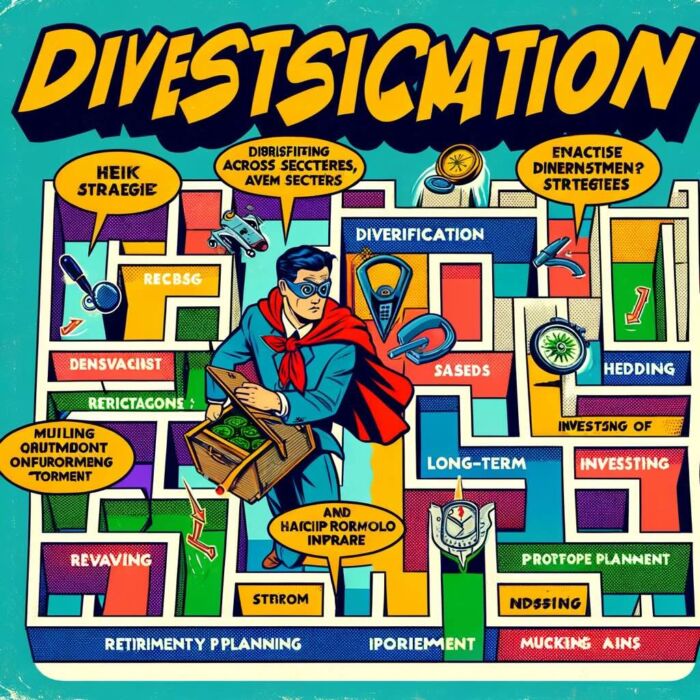In today’s fast-paced and ever-changing financial landscape, building a strong investment portfolio has become crucial for individuals seeking financial security and long-term growth. An investment portfolio serves as a carefully constructed collection of various assets, strategically chosen and managed to maximize returns while minimizing risks.

Importance of building a strong investment portfolio
It provides a roadmap towards achieving your financial goals, whether it’s funding your children’s education, purchasing a dream home, or ensuring a comfortable retirement.
Building a strong investment portfolio is not just reserved for the wealthy or financial experts. It is a pathway available to anyone willing to dedicate time and effort to understand the principles of investing and apply them wisely. By establishing a solid investment foundation, you can take control of your financial future and potentially unlock a world of opportunities.

Benefits of a diversified portfolio
One key principle that underpins the construction of a strong investment portfolio is diversification. Diversifying your portfolio involves spreading your investments across different asset classes, sectors, and geographic regions. By doing so, you can mitigate the impact of any single investment’s performance on your overall portfolio. Diversification acts as a risk management tool, ensuring that if one investment underperforms, others may compensate for the loss. It also allows you to participate in various market trends and capitalize on potential growth areas, increasing your chances of achieving favorable returns.
A diversified portfolio offers several benefits. First and foremost, it helps reduce risk by avoiding over-reliance on a single investment or market segment. By spreading your investments, you create a safety net that cushions the impact of market volatility. Additionally, a diversified portfolio provides the potential for consistent returns over the long term. While some investments may experience fluctuations, others may be performing well, balancing out the overall portfolio performance. Moreover, diversification allows you to tap into different asset classes with varying risk and return characteristics, giving you exposure to a broader range of investment opportunities.

Building A Robust Portfolio
In this comprehensive guide, we will take you on a journey to build a robust and well-structured investment portfolio. We will delve into various crucial aspects of portfolio construction, equipping you with the knowledge and tools needed to make informed investment decisions.
The guide begins by helping you understand your investment goals and risk tolerance. We will explore the importance of defining both short-term and long-term investment objectives, taking into account factors such as your financial aspirations, time horizon, and comfort level with risk. By aligning your investments with your goals and risk tolerance, you can create a portfolio that reflects your unique needs and expectations.
Next, we will dive into asset allocation strategies. Asset allocation refers to the process of determining how to distribute your investments among different asset classes, such as stocks, bonds, real estate, and commodities. We will explore the characteristics of each asset class, their historical performance, and how they may fit into your portfolio based on your risk profile and prevailing market conditions. We will also discuss the importance of periodically rebalancing your portfolio to maintain the desired asset allocation mix.
Researching and analyzing investment options is a critical step in building a strong portfolio. We will guide you through the process of conducting fundamental analysis, which involves evaluating company financials, industry trends, and competitive landscapes. Additionally, we will explore the realm of technical analysis, where you will learn to interpret charts, identify patterns, and use indicators to make investment decisions. We will also provide insights into different investment opportunities, such as growth stocks, value stocks, mutual funds, exchange-traded funds (ETFs), and alternative investments, enabling you to make well-informed investment choices.

Diversification and Risk Management
Diversification and risk management will be another key focus of our guide. We will explain the concept of diversification in detail and emphasize its importance in managing risk effectively. We will explore strategies for building a diversified portfolio that encompasses various sectors, asset classes, and geographic regions. Additionally, we will discuss risk management techniques, such as employing hedging strategies and utilizing stop-loss orders, to protect your portfolio from adverse market movements.
Long-term investing and retirement planning will also feature prominently in our guide. We will uncover the benefits of adopting a long-term investment approach and the significance of planning for retirement. You will gain insights into structuring your investments for long-term growth and learn about tax-efficient investing strategies for retirement accounts.
Monitoring and reviewing your portfolio regularly is vital for its ongoing success. We will discuss the importance of tracking investment performance, evaluating portfolio returns, and making adjustments when necessary. Additionally, we will highlight the value of staying informed about market trends and news that can impact your investments. Seeking professional advice when needed will also be emphasized to ensure you have access to expert guidance throughout your investment journey.
To wrap up our comprehensive guide, we will explore common investment pitfalls to avoid. Emotional investing, chasing quick gains, overconfidence, and neglecting due diligence are some of the traps investors can fall into. By being aware of these pitfalls, you can navigate the investment landscape more effectively and make informed decisions that align with your goals.
Building a strong investment portfolio is a dynamic and continuous process. We will conclude by emphasizing the importance of continuous learning, adaptability, and staying abreast of changing market conditions. Armed with knowledge and a structured approach, you can confidently embark on your investment journey and work towards achieving your financial aspirations. So, let’s dive in and discover the potential of building a strong investment portfolio tailored to your needs and aspirations.

Understanding Investment Goals and Risk Tolerance
Defining short-term and long-term investment goals
Before diving into the world of investing, it’s crucial to define your investment goals. What are you striving to achieve? What milestones do you want to reach? By clearly outlining your objectives, you can create a roadmap for your investment journey.
Short-term investment goals typically encompass a timeframe of one to three years. These goals might include saving for a down payment on a house, funding a dream vacation, or paying off high-interest debt. Short-term goals require a more conservative investment approach, as capital preservation and liquidity become key considerations.
On the other hand, long-term investment goals extend beyond three years and often revolve around financial milestones like retirement planning, children’s education, or building wealth over time. Long-term goals allow for a more aggressive investment strategy, as there is more time to weather market volatility and pursue higher returns.
Assessing risk tolerance and investment horizon
Understanding your risk tolerance is an essential step in building a strong investment portfolio. Risk tolerance refers to your ability to handle fluctuations in the value of your investments and withstand potential losses. Each person’s risk tolerance varies based on factors such as financial circumstances, investment knowledge, time horizon, and psychological disposition.
To assess your risk tolerance, ask yourself: How comfortable am I with the possibility of losing money? Can I withstand short-term market volatility? Am I more focused on preserving capital or seeking higher returns?
Your investment horizon is another crucial factor. It represents the length of time you expect to remain invested before needing the funds for your goals. A longer investment horizon allows for greater risk-taking and potential recovery from market downturns. Conversely, a shorter investment horizon calls for a more conservative approach to protect your capital and ensure it’s available when needed.
Aligning investments with goals and risk tolerance
Once you have defined your investment goals and assessed your risk tolerance and investment horizon, it’s time to align your investments accordingly. A key principle in portfolio construction is to match investments with specific objectives and risk profiles.
For short-term goals, focus on investments that prioritize capital preservation and provide liquidity. Options may include high-yield savings accounts, money market funds, or short-term bonds. These investments offer stability and easy access to your funds when you need them most.
For long-term goals, you can afford to take on more risk in pursuit of higher returns. Consider allocating a portion of your portfolio to growth-oriented assets such as stocks or equity funds. While these investments may experience short-term volatility, they have historically outperformed other asset classes over the long run.
To strike a balance between risk and reward, diversification is key. Allocate your investments across different asset classes, sectors, and geographic regions to reduce the impact of any single investment on your overall portfolio. Diversification spreads risk and enhances the potential for stable returns.
It’s essential to review and adjust your portfolio periodically to ensure it remains aligned with your goals and risk tolerance. As life circumstances change, your investment strategy may need to evolve accordingly. Regular evaluation will help you stay on track and make any necessary adjustments to keep your portfolio in line with your desired outcomes.
Remember, investing is a personal journey, and there’s no one-size-fits-all approach. Consider working with a financial advisor who can provide personalized guidance and help you navigate the intricacies of aligning your investments with your unique goals and risk tolerance. With a well-aligned portfolio, you’ll be better positioned to achieve your financial aspirations while maintaining peace of mind along the way.
source: Toby Newbatt on YouTube
Asset Allocation Strategies
Explaining asset allocation and its role in portfolio construction
Asset allocation lies at the core of building a strong investment portfolio. It refers to the process of dividing your investments among different asset classes, such as stocks, bonds, real estate, and commodities, to achieve a balance between risk and reward. Asset allocation plays a vital role in portfolio construction as it determines the overall risk and potential return of your investments.
The primary objective of asset allocation is to create a diversified portfolio that can weather various market conditions. By spreading your investments across different asset classes, you can potentially reduce the impact of any single investment’s performance on your overall portfolio. The goal is to find the optimal mix of assets that aligns with your risk tolerance, investment goals, and market outlook.
Different asset classes: stocks, bonds, real estate, etc.
Understanding different asset classes is crucial for effective asset allocation. Here are some key asset classes commonly considered in portfolio construction:
- Stocks: Stocks represent ownership shares in publicly traded companies. They offer the potential for long-term capital appreciation and dividend income. Stocks are known for their higher volatility and growth potential.
- Bonds: Bonds are debt securities issued by governments, municipalities, and corporations. They provide fixed interest payments over a specified period, with the return of principal at maturity. Bonds are generally considered lower risk than stocks and offer more stable income.
- Real Estate: Real estate investments include residential properties, commercial properties, and real estate investment trusts (REITs). Real estate offers potential income through rental payments and the potential for capital appreciation.
- Commodities: Commodities include physical goods such as gold, oil, agricultural products, and natural resources. They can act as a hedge against inflation and provide diversification benefits due to their low correlation with traditional asset classes.
- Alternative Investments: Alternative investments encompass a wide range of non-traditional assets, such as private equity, hedge funds, venture capital, and cryptocurrencies. These investments offer unique risk-return characteristics and can provide diversification benefits.

Determining optimal asset allocation based on risk profile and market conditions
Determining the optimal asset allocation for your portfolio involves considering your risk profile and market conditions. Your risk profile, which includes factors like risk tolerance, time horizon, and financial goals, helps guide the level of risk you are willing to take on.
A conservative investor with a lower risk tolerance may opt for a higher allocation to bonds and cash equivalents, focusing on capital preservation and income generation. Conversely, an aggressive investor seeking higher returns may allocate a larger portion to stocks and alternative investments, accepting higher volatility in pursuit of capital appreciation.
Market conditions also play a role in determining asset allocation. During periods of economic uncertainty, you may consider allocating more to defensive assets like bonds and gold. In times of economic expansion, you may tilt your allocation towards growth-oriented assets like stocks and real estate.
Rebalancing the portfolio periodically
Periodic portfolio rebalancing is crucial to maintain your desired asset allocation. Over time, the performance of different asset classes can deviate, leading to an imbalance in your portfolio. Rebalancing involves realigning your portfolio back to its original asset allocation.
Rebalancing typically involves selling some assets that have performed well and allocating the proceeds to underperforming assets. This disciplined approach allows you to buy low and sell high, capturing potential opportunities and reducing excessive exposure to specific assets.
The frequency of portfolio rebalancing depends on your investment strategy and market conditions. Some investors rebalance on a predetermined schedule (e.g., annually or semi-annually), while others rebalance when the asset allocation deviates significantly from the target allocation.
Remember, asset allocation is not a one-time decision but an ongoing process. As your financial situation, goals, and market conditions evolve, you may need to adjust your asset allocation to ensure it remains aligned with your objectives. Regular monitoring and periodic rebalancing will help you maintain a well-diversified portfolio that reflects your risk tolerance and optimizes your chances of achieving long-term financial success.
source: Learn To Invest – Investors Grow on YouTube
Researching and Analyzing Investment Options
Conducting fundamental analysis: company financials, industry trends, etc.
When researching investment options, conducting fundamental analysis is a crucial step. Fundamental analysis involves evaluating the intrinsic value of a company or investment by examining various factors such as company financials, industry trends, competitive landscape, and management quality.
Start by studying a company’s financial statements, including its income statement, balance sheet, and cash flow statement. Analyze revenue growth, profitability, debt levels, and cash flow trends. Assess key financial ratios such as price-to-earnings (P/E) ratio, return on equity (ROE), and debt-to-equity ratio to gauge the company’s financial health and performance.
Beyond financials, examine the broader industry trends and dynamics. Understand the market position of the company and its competitors, industry growth prospects, and any regulatory or technological factors that may impact the industry’s future. Assessing the competitive landscape and a company’s ability to adapt to changing market conditions is essential in evaluating its long-term prospects.

Utilizing technical analysis: charts, patterns, and indicators
Technical analysis is another valuable tool to consider when analyzing investment options. Unlike fundamental analysis, which focuses on company-specific factors, technical analysis examines historical price and volume patterns to predict future price movements.
Utilize charts and technical indicators to identify trends, support and resistance levels, and patterns such as head and shoulders, double tops or bottoms, and moving averages. Technical indicators, such as relative strength index (RSI), moving average convergence divergence (MACD), and stochastic oscillators, provide additional insights into market sentiment and potential entry or exit points.
Combining fundamental and technical analysis can provide a well-rounded perspective on investment opportunities. While fundamental analysis helps assess the intrinsic value and long-term prospects, technical analysis can provide insights into optimal timing and entry points.
Evaluating investment opportunities: growth stocks, value stocks, mutual funds, ETFs, etc.
When evaluating investment opportunities, consider various options based on your investment goals, risk tolerance, and time horizon.
- Growth Stocks: Growth stocks are shares of companies that are expected to grow at an above-average rate compared to the overall market. These companies often reinvest earnings back into the business to fuel expansion. Assess factors such as revenue growth, earnings growth potential, and the company’s competitive advantages.
- Value Stocks: Value stocks are shares of companies that are considered undervalued based on fundamental analysis. Look for companies with strong financials, stable cash flows, and a favorable price-to-earnings ratio relative to their peers. Value stocks may offer attractive long-term potential as the market recognizes their true worth.
- Mutual Funds and ETFs: Mutual funds and exchange-traded funds (ETFs) offer diversified investment options managed by professional fund managers. Evaluate factors such as fund objectives, expense ratios, historical performance, and the fund manager’s track record. Consider whether the fund aligns with your investment goals and risk tolerance.
- Fixed Income Investments: Fixed income investments, such as bonds and bond funds, provide regular interest income and return of principal at maturity. Assess factors such as credit rating, yield, duration, and the issuer’s financial strength. Consider the interest rate environment and how it may impact bond prices.
Considering alternative investments and their potential benefits
In addition to traditional investment options, alternative investments can offer unique benefits and diversification. Alternative investments encompass a range of assets beyond stocks and bonds and can include private equity, hedge funds, real estate, commodities, and cryptocurrencies.
Alternative investments often have lower correlation with traditional asset classes, providing potential portfolio diversification. For example, real estate investments can generate income and offer potential capital appreciation, while commodities can act as a hedge against inflation.
When considering alternative investments, it’s essential to understand the risks and conduct thorough due diligence. Some alternative investments may have higher fees, limited liquidity, and specific regulatory considerations. Assess the investment’s historical performance, underlying assets, and the expertise and reputation of the investment manager or sponsor.
As with any investment, it’s crucial to evaluate alternative investments within the context of your overall portfolio and investment objectives. Seek advice from financial professionals experienced in alternative investments to ensure they align with your risk tolerance and long-term goals.
By conducting comprehensive research, combining fundamental and technical analysis, and evaluating various investment options, you can make well-informed decisions and construct a diversified portfolio tailored to your specific investment goals and risk profile. Remember, staying informed and continuously learning about different investment opportunities is key to successful portfolio management.
source: Darwinex on YouTube
Diversification and Risk Management
Explaining the concept of diversification
Diversification is a fundamental principle in building a strong investment portfolio. It involves spreading your investments across different sectors, asset classes, and geographic regions to reduce risk and enhance potential returns. The idea behind diversification is to avoid overexposure to any single investment or market segment, reducing the impact of individual investment performance on your overall portfolio.
The rationale behind diversification lies in the fact that different assets tend to behave differently in various market conditions. By diversifying your portfolio, you can potentially offset losses in one investment with gains in another. Diversification provides a safety net, helping to protect your portfolio from extreme market fluctuations and reducing the likelihood of catastrophic losses.
Building a diversified portfolio across different sectors and asset classes
Building a diversified portfolio requires careful consideration of asset allocation and sector allocation. Start by allocating your investments across different asset classes such as stocks, bonds, real estate, and commodities. Each asset class has its own risk and return characteristics, and they may perform differently under various economic conditions.
Within each asset class, further diversify your investments across different sectors. For example, in the stock market, consider investing in companies from various sectors like technology, healthcare, finance, consumer goods, and energy. This ensures that your portfolio isn’t overly concentrated in one industry, reducing sector-specific risks.
Diversification also extends to geographic regions. Consider allocating a portion of your portfolio to international markets, as different countries and regions may experience economic cycles at different times. This global diversification helps mitigate country-specific risks and exposes you to a broader range of investment opportunities.

Managing risk through diversification and hedging strategies
Diversification is a powerful risk management tool. By spreading your investments, you can reduce the impact of any single investment or market event on your portfolio. However, it’s important to note that diversification does not guarantee profits or protect against losses in a declining market. It is a strategy to manage risk, not eliminate it entirely.
In addition to diversification, consider employing hedging strategies to further manage risk. Hedging involves taking positions that offset potential losses in your portfolio. For example, you could purchase put options as a form of insurance against a decline in the value of your stock holdings. Hedging strategies can provide some downside protection and help mitigate the impact of adverse market movements.
Using stop-loss orders and other risk management techniques
Implementing risk management techniques is crucial in protecting your investment portfolio. One effective tool is the use of stop-loss orders. A stop-loss order is an instruction to sell a security if it reaches a predetermined price level. By setting stop-loss orders, you can limit potential losses by automatically selling a security if its price falls below a certain threshold. This helps prevent emotional decision-making and ensures that you exit a position before losses become excessive.
Other risk management techniques include setting realistic investment goals, maintaining an emergency fund to cover unexpected expenses, and regularly reviewing your portfolio’s performance. Keep track of economic and market trends, and adjust your investment strategy if needed. Consider working with a financial advisor who can provide guidance and expertise in managing risk and aligning your investments with your risk tolerance and goals.
Remember, risk is inherent in investing, but through diversification, hedging, and proactive risk management, you can strike a balance between potential returns and prudent risk management.
source: Jazz Wealth Managers on YouTube
Long-Term Investing and Retirement Planning
Benefits of long-term investing
Long-term investing is a powerful strategy that offers several benefits for individuals seeking financial growth and security. Here are some key advantages of adopting a long-term investment approach:
- Compound Growth: Long-term investing allows you to harness the power of compounding. By reinvesting your investment gains over time, you can potentially earn returns not just on your initial investment but also on the accumulated gains. Compounding can significantly amplify your wealth over the long run.
- Weathering Market Volatility: Long-term investing provides the opportunity to ride out short-term market fluctuations. By maintaining a long-term perspective, you can avoid making impulsive investment decisions based on short-term market volatility. Over time, the impact of market downturns tends to diminish, and the potential for positive returns increases.
- Capturing Growth Opportunities: Investing for the long term enables you to benefit from the growth potential of quality investments. It allows you to participate in economic expansions, technological advancements, and global trends that can drive the value of your investments over time. By staying invested, you have a higher likelihood of capturing long-term market gains.
Importance of retirement planning and investing for retirement
Retirement planning is a critical aspect of long-term investing. Planning and investing for retirement ensures that you have the financial means to maintain a comfortable lifestyle when you stop working. Here’s why retirement planning is essential:
- Longer Lifespans: With increasing life expectancies, retirement can span several decades. It’s crucial to have sufficient financial resources to support yourself during this extended period. Proper retirement planning allows you to accumulate the necessary funds to meet your lifestyle and healthcare needs throughout your retirement years.
- Inflation Protection: Inflation erodes the purchasing power of your money over time. Retirement planning and investing help you combat inflation by aiming for returns that outpace the rising cost of living. By investing in assets that historically have provided higher returns, such as stocks, you can better preserve your purchasing power.
- Peace of Mind: Retirement planning provides peace of mind and reduces financial stress. Knowing that you have a well-thought-out plan in place, with investments aligned with your retirement goals, allows you to focus on enjoying your retirement years without constant financial worries.

Strategies for building a retirement portfolio
Building a retirement portfolio requires a thoughtful approach tailored to your individual circumstances. Here are some key strategies to consider:
- Start Early and Save Regularly: The earlier you start saving for retirement, the better. Time is your greatest ally when it comes to building wealth. Make it a habit to contribute regularly to retirement accounts such as 401(k)s, individual retirement accounts (IRAs), or employer-sponsored pension plans.
- Determine Your Risk Tolerance: Assess your risk tolerance and align your retirement investments accordingly. Generally, younger individuals with a longer time horizon can afford to take more risk and allocate a higher percentage to growth-oriented assets like stocks. As you approach retirement, consider gradually shifting towards more conservative investments to protect your accumulated wealth.
- Diversify Your Retirement Portfolio: Diversification is crucial in retirement investing to mitigate risks. Allocate your retirement investments across different asset classes such as stocks, bonds, and cash equivalents. Within each asset class, diversify further by investing in various sectors and geographic regions.
- Regularly Review and Rebalance: Periodically review your retirement portfolio to ensure it remains aligned with your goals and risk tolerance. Rebalance if necessary, by adjusting the asset allocation to maintain the desired mix. As you near retirement, consider adjusting your portfolio to prioritize income generation and capital preservation.
Tax-efficient investing for retirement accounts
Tax efficiency is an important consideration when investing for retirement. Here are a few strategies to optimize your retirement accounts from a tax perspective:
- Utilize Tax-Advantaged Retirement Accounts: Take advantage of tax-advantaged retirement accounts like traditional IRAs, Roth IRAs, and 401(k)s. Contributions to traditional IRAs and 401(k)s are often tax-deductible, providing immediate tax benefits. Roth IRAs offer tax-free withdrawals in retirement.
- Maximize Employer Matching Contributions: If your employer offers a matching contribution to your retirement plan, strive to contribute enough to receive the maximum match. Employer matching is essentially free money that can significantly boost your retirement savings.
- Consider Tax-efficient Investments: When selecting investments for your retirement portfolio, consider their tax implications. Certain investments, such as tax-efficient mutual funds or index funds, generate fewer taxable events compared to actively managed funds. Municipal bonds may also offer tax advantages for certain investors.
- Tax-Loss Harvesting: In taxable investment accounts, consider implementing tax-loss harvesting. This involves strategically selling investments that have declined in value to offset capital gains and reduce taxable income.
Consult with a financial advisor or tax professional to optimize your retirement accounts from a tax perspective and ensure you are taking advantage of all available tax-saving strategies.
Remember, retirement planning is a long-term endeavor. Regularly assess your retirement goals, review your portfolio, and make adjustments as needed to stay on track. By adopting a disciplined approach to retirement planning and investing, you can work towards achieving a financially secure and fulfilling retirement.
source: Interactive Investor on YouTube
Monitoring and Reviewing the Portfolio

Regularly reviewing investment performance and goals
Monitoring your investment portfolio is crucial for maintaining its health and aligning it with your financial goals. Regularly review your portfolio’s performance and track how it is progressing toward your investment objectives. Set a schedule for portfolio reviews, whether it’s quarterly, semi-annually, or annually, and stick to it.
During these reviews, assess the performance of individual investments, comparing them to relevant benchmarks or indices. Identify any underperforming investments and understand the reasons behind their performance. Determine whether any changes in the investment landscape or market conditions warrant adjustments to your portfolio strategy.
Analyzing portfolio returns and making adjustments if necessary
Analyze your portfolio returns to gain insights into its overall performance. Calculate metrics such as the overall return on investment (ROI), the annualized rate of return, and the risk-adjusted return. Compare these metrics to your expectations and consider whether they align with your long-term goals.
If your portfolio is not performing as expected or if certain investments consistently underperform, it may be necessary to make adjustments. Consider the reasons behind the underperformance and reassess the investment’s fundamentals. Determine whether it is prudent to reallocate or replace underperforming investments with more promising opportunities that align with your investment strategy.
![]()
Tracking market trends and adjusting the portfolio accordingly
Keep a close eye on market trends and economic indicators that may impact your investments. Stay informed about the broader market conditions, industry-specific developments, and geopolitical factors that may influence the performance of your portfolio. Regularly read financial news, research reports, and market analyses to gain insights into market trends.
Adjust your portfolio strategy based on evolving market conditions. For example, during periods of economic expansion and positive market sentiment, you might consider allocating more to growth-oriented assets. In contrast, during periods of economic uncertainty or market volatility, you may choose to allocate more to defensive assets or increase cash reserves.
Seeking professional advice, if needed
If you feel overwhelmed or lack the expertise to effectively manage your portfolio, don’t hesitate to seek professional advice. Financial advisors can provide valuable insights, expertise, and guidance tailored to your specific financial situation and goals.
A financial advisor can help you assess your risk tolerance, analyze your investment portfolio, and make recommendations based on their expertise and market insights. They can also provide guidance on tax planning, retirement strategies, and overall financial planning.
When selecting a financial advisor, consider their qualifications, experience, and track record. Look for advisors who have relevant certifications, such as Certified Financial Planner (CFP), and who adhere to fiduciary standards, meaning they are obligated to act in your best interest.
In summary, regular monitoring and review of your investment portfolio are essential to ensure it remains aligned with your goals and adapts to changing market conditions. By analyzing performance, tracking market trends, and seeking professional advice when needed, you can optimize your portfolio’s performance and increase the likelihood of achieving your long-term financial objectives.
source: Yahoo Finance on YouTube
Common Investment Pitfalls to Avoid
Investing can be a rewarding endeavor, but it’s essential to navigate the market with caution and avoid common pitfalls that can hinder your success. Here are some key pitfalls to steer clear of:
Emotional investing and herd mentality
Emotional investing is a major pitfall that can derail your investment journey. Making investment decisions based on fear, greed, or panic can lead to irrational choices and detrimental outcomes. Avoid succumbing to emotional impulses, as they often cloud judgment and lead to poor investment decisions.
Another related pitfall is herd mentality, where investors blindly follow the crowd without conducting their own research. Just because everyone is investing in a particular asset or following a particular trend doesn’t mean it’s the right choice for you. Remember that the market is driven by a variety of factors, and blindly following the crowd can lead to unfavorable outcomes.
To avoid emotional investing and herd mentality, develop a disciplined investment strategy based on thorough analysis and stick to it. Maintain a long-term perspective, focus on your own financial goals, and don’t let short-term market fluctuations sway your decision-making.

Chasing quick gains and ignoring long-term prospects
One common pitfall is the desire to chase quick gains. It’s tempting to jump on investment trends or hot tips in the hopes of making fast profits. However, such speculative approaches often lead to disappointment and losses. Sustainable investment success comes from focusing on long-term prospects and underlying fundamentals.
Instead of seeking short-term gains, take a patient and disciplined approach. Conduct thorough research, assess the long-term potential of investments, and align them with your investment goals. Remember that building wealth takes time and requires a focus on consistent, long-term growth rather than short-term speculative gains.
Overconfidence and neglecting due diligence
Overconfidence can be a dangerous pitfall for investors. Feeling overly confident in your investment abilities may lead to excessive risk-taking or neglecting proper due diligence. It’s important to recognize that no one can consistently predict market movements or outperform the market consistently.
Avoid overconfidence by maintaining a realistic perspective on your abilities and the inherent uncertainties of investing. Conduct thorough due diligence on investments, evaluate risks, and seek diverse sources of information. Be aware of your limitations and consider seeking advice from financial professionals when necessary.

Failing to stay updated with market trends and news
Staying updated with market trends and news is crucial for informed decision-making. Failing to do so can leave you unaware of significant market developments, economic indicators, or changes in industry landscapes. This lack of information can lead to missed opportunities or being caught off-guard by market shifts.
Make it a habit to stay informed by following reliable financial news sources, reading market analyses, and tracking relevant economic indicators. Stay attuned to industry trends, regulatory changes, and geopolitical events that may impact your investments. Regularly review your portfolio and adjust your strategy as needed based on the latest information.
By avoiding emotional investing, resisting the urge to chase quick gains, conducting thorough due diligence, and staying informed, you can steer clear of common investment pitfalls. Cultivate a disciplined approach, adhere to your long-term investment strategy, and make decisions based on careful analysis rather than short-term emotions. Remember, investing is a journey that requires patience, prudence, and continuous learning to achieve long-term financial success.
source: Humphrey Yang on YouTube
Conclusion: Creating A Strong Investment Portfolio
In this comprehensive guide to building a strong investment portfolio, we have covered several key points to help you navigate the world of investing. We emphasized the importance of building a strong investment portfolio to achieve financial security and long-term growth. Diversification emerged as a crucial strategy, spreading your investments across different asset classes, sectors, and geographic regions to mitigate risk. We explored the significance of understanding your investment goals, risk tolerance, and time horizon, aligning your investments accordingly. We discussed the value of conducting fundamental and technical analysis, evaluating various investment options, and considering alternative investments for diversification. Additionally, we highlighted the importance of long-term investing, retirement planning, and tax-efficient strategies for retirement accounts. Managing risk through diversification, hedging, and risk management techniques was emphasized, along with the significance of regularly monitoring and reviewing your portfolio.

Start building a strong investment portfolio
Now that you have gained insights into the key aspects of portfolio construction, it’s time to take action and start building your strong investment portfolio. Regardless of your financial background or current resources, investing is a journey that is open to anyone willing to learn and adapt.
Don’t be discouraged by the complexities of investing. Remember that building a strong portfolio is a gradual process that requires patience, discipline, and continuous learning. Start by defining your investment goals and risk tolerance, aligning them with your desired outcomes. Explore different asset classes, evaluate investment options, and diversify your portfolio to manage risk effectively. Regularly review your investments, stay informed about market trends, and make adjustments when necessary.

Importance of continuous learning and adaptation in investing
Investing is not a one-time activity but a lifelong journey. The financial landscape evolves, markets change, and new opportunities arise. Therefore, continuous learning and adaptation are essential to succeed as an investor.
Commit yourself to ongoing education about investment strategies, market trends, and new investment products. Stay informed through books, articles, podcasts, and reputable financial news sources. Consider attending seminars, webinars, or workshops to enhance your knowledge and skills.
Adaptability is equally important. Be open to adjusting your investment approach based on changing market conditions and life circumstances. Regularly reassess your investment goals, risk tolerance, and time horizon to ensure they remain aligned with your current situation and aspirations.
Remember that investing involves risks, and past performance is not indicative of future results. Seek professional advice when needed, especially for complex investment strategies or retirement planning.
By building a strong investment portfolio, you are taking control of your financial future and working towards achieving your long-term goals. With a foundation of knowledge, a disciplined approach, and a willingness to adapt, you can navigate the intricacies of investing and increase your chances of attaining financial prosperity.
So, take the first step today and embark on your journey to build a strong investment portfolio. Your financial aspirations are within reach, and with dedication and perseverance, you can unlock the potential of the financial markets and create a brighter future for yourself and your loved ones.
Important Information
Investment Disclaimer: The content provided here is for informational purposes only and does not constitute financial, investment, tax or professional advice. Investments carry risks and are not guaranteed; errors in data may occur. Past performance, including backtest results, does not guarantee future outcomes. Please note that indexes are benchmarks and not directly investable. All examples are purely hypothetical. Do your own due diligence. You should conduct your own research and consult a professional advisor before making investment decisions.
“Picture Perfect Portfolios” does not endorse or guarantee the accuracy of the information in this post and is not responsible for any financial losses or damages incurred from relying on this information. Investing involves the risk of loss and is not suitable for all investors. When it comes to capital efficiency, using leverage (or leveraged products) in investing amplifies both potential gains and losses, making it possible to lose more than your initial investment. It involves higher risk and costs, including possible margin calls and interest expenses, which can adversely affect your financial condition. The views and opinions expressed in this post are solely those of the author and do not necessarily reflect the official policy or position of anyone else. You can read my complete disclaimer here.






